
Hot Springs World Class High School (HSWCHS) is a public magnet secondary school located in Hot Springs, Arkansas, United States. HSWCHS is one of seven public high schools in Garland County and the sole high school of the Hot Springs School District. The school's 1914 facility is listed on the National Register of Historic Places and its academic programs include Advanced Placement (AP) coursework and International Baccalaureate (IB) Diploma Programme.
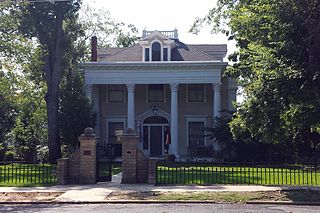
The William H. Martin House is a historic house at 815 Quapaw Avenue in Hot Springs, Arkansas. It was designed by architect Frank W. Gibb in 1904 and built in the same year. It includes Colonial Revival and Classical Revival architectural elements. It is an imposing building with a two-story Greek temple portico supported by four fluted Corinthian style pillars. The portico's cornice is modillioned with scrolled brackets, and has a band of dentil molding. When built, the house was on the outskirts of Hot Springs.
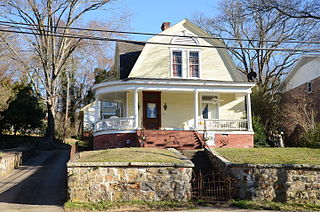
The Fordyce House is a historic house at 746 Park Avenue in Hot Springs, Arkansas. It is a 1-1/2 story wood frame structure, with a hip roof that has large cross-gabled gambrel dormers projecting in each direction. It has a curved wraparound porch supported by Tuscan columns. It was built in 1910 to a design by architect Charles L. Thompson, and is an excellent local example of Colonial Revival architecture.

John Parks Almand was an American architect who practiced in Arkansas from 1912 to 1962. Among other works, he designed the Art Deco Hot Springs Medical Arts Building, which was the tallest building in Arkansas from 1930 to 1958. Several of his works, including the Medical Arts Building and Little Rock Central High School, are listed on the National Register of Historic Places.

The Shiloh House is a historic house on Cliff Road in Sulphur Springs, Benton County, Arkansas. Built in 1927, it is one of the largest examples of Bungalow-style architecture in Benton County. Set on a steeply sloping lot above Cliff Road, it is two stories at the front and three at the back, with a broad single-story porch which extends over a carport to the right. The porch is supported by supports that are a combination of brick piers and boxed columns, joined by a brick balustrade.
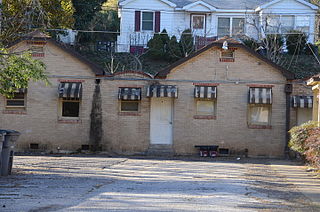
The Bellaire Court Historic District encompasses a former tourist court cottage complex at 637 Park Avenue in Hot Springs, Arkansas. The complex was built in the 1930s, when the advent of vacation travel by automobile rose to prominence. The complex is roughly L-shaped, with a long leg of the L perpendicular to the road, and the short leg at the rear, facing Magnolia Street. It is a single story structure with Craftsman styling, built out of wood and finished in stone veneer and brick trim. At the front of the complex is a manager's house, with cottage-style units lined behind it, each with a space that was originally a garage, but has since been filled in as part of a conversion to full-time residential units.

The Cottage Courts Historic District encompasses a historic travelers' accommodation at 609 Park Avenue in Hot Springs, Arkansas. Built about 1950, it was one of the first motel-type tourist accommodations to be built in the city. Unlike earlier tourist courts, which typically had idiosyncratic vernacular architecture, Cottage Courts consists of two ranch-style single-story buildings, one of which houses twelve guest rooms, and the other three plus the operator's apartment and office.

The Lake Catherine State Park CCC Cabins are a collection of four rustic cabins constructed by crews of the Civilian Conservation Corps in what is now Lake Catherine State Park in Hot Spring County, Arkansas. Three of the four cabins were built for use as tourist accommodations and continue to serve in that role, while the fourth, probably built to house administrative functions, is now used in the state park as a "nature cabin", with exhibits on the history and natural environment of the park. Three of the cabins were separately listed on the National Register of Historic Places in 1992; the fourth was listed in 1995.

Cove Tourist Court is a historic former tourist accommodation at 771 Park Avenue in Hot Springs, Arkansas. It is a U-shaped facility, a single story in height, built with wood framing and a stucco exterior in the International Style of architecture. Each of the nine units has an entrance sheltered by a shed roof with Craftsman brackets, and a single-car garage with a two-leaf hinged door. Built about 1937, it is a well-preserved example of the tourist court form in International Style. It has since been converted into residential apartments.

Humphrey's Dairy Farm is a historic farm property at 1675 Shady Grove Road in Garland County, Arkansas, several miles southeast of Hot Springs. The farm is now a 12-acre (4.9 ha) remnant of a property that was once more than 400 acres (160 ha). The farm complex is set on the north side of the road, and includes a large Craftsman house, built about 1920, a derelict gambrel-roofed barn of similar vintage, and a dairy processing plant built about 1930. The farm was started by Harris Humphrey in 1911, and was for many years an important local supplier to the Hot Springs market.

The Humphreys-Ryan House is a historic house at 137 Garland Avenue in Hot Springs, Arkansas. It is a 1-1/2 story wood frame structure, with a cross-gable roof, clapboard siding, and a brick foundation. A single-story porch extends across the front, supported by Tuscan columns with a simple stick balustrade. Built in 1910 by Charles Humphreys, a local drugstore manager, it is a well-preserved local example of Colonial Revival architecture.
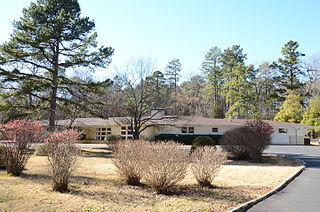
The Peter Dierks Joers House is a historic house at 2111 Park Avenue in Hot Springs, Arkansas. Built in 1955, this single story wood and limestone structure is one of the finest local examples of Mid-Century Modern / Ranch architecture. The house is basically U-shaped, with a central public living area, a bedroom wing, and a service wing. Windows are typically full length in height, and most of the exterior is clad in irregularly-laid limestone, with some weatherboard siding. The house was built for Peter Dierks Joers, heir to the locally prominent Dierks Lumber Company, whose sale to Weyerhaeuser he oversaw. The house interior is a showcase of Arkansas wood types and woodwork.

The George Klein Tourist Court Historic District, also known as Green Elf Court, is a historic tourist accommodation at 501 Morrison Street in Hot Springs, Arkansas. Now an apartment complex, it consists of seven single-story cabins, an elaborate American Craftsman style manager's house, and an octagonal central residence unit with a cantilevered second floor and a bellcast roof. The complex was built about 1940, is one of the city's finest example of a Craftsman style tourist court, a popular form of traveler accommodation prior to World War II.

The Hodges House is a historic house on the east side of Arkansas Highway 7 south of the rural community of Bismarck, Arkansas. It is a distinctive single-story wood-frame house, with a projecting polygonal bay at one corner, and a porch that wraps around three sides of the house. The porch is supported by turned posts and has an elaborate Folk Victorian balustrade. The house was built in 1907 by Lee and Clara DeBray, and was sold to Thomas and Charlotte Hodges in 1925. Both of the Hodgeses were leading figures in the early development of archaeology in the state of Arkansas, amassing a collection of more than 50,000 artifacts, and occupying leadership positions in the Arkansas Archaeological Society. The Menard-Hodges Site, now a National Historic Landmark, was purchased by Hodges in order to control research and preservation activities.

The Parkway Courts Historic District encompasses a historic tourist accommodation at 815 Park Avenue in Hot Springs, Arkansas. It is a U-shaped tourist court, with 48 units and a building housing an office and manager's residence. The units come in three styles, some with larger sleeping and living spaces, and some with kitchenettes. Each unit is highlighted architecturally by a steeply pitched gable over the entrance. The buildings are brick. The units were built in 1943, and the manager's residence/office in 1950, after the original burned down. It is one of the city's oldest surviving tourist courts.

The Passmore House is a historic house at 846 Park Avenue in Hot Springs, Arkansas. It is a large 1-1/2 story wood frame structure, with a seven-bay facade topped by a mansard roof with a crested surround and elaborately styled dormers. A central two-story pavilion projects, with a double-door entrance on the first floor, and French doors on the second level that open to a shallow lattice balcony. The house was built in 1873 for Dr. Pauldin Passmore, one of Hot Springs's first doctors, who benefitted from the locality's popularity as a site for the treatment of medical conditions.

The Perry Plaza Court Historic District encompasses a historic tourist accommodation at 1007 Park Avenue in Hot Springs, Arkansas. It consists of a long two-story brick building in the International style, along with a small office building and swimming pool. It houses 19 single-bedroom units, which are now rented as apartments. Built in 1947–48, it is a fine example of the International Style. The unit interiors retain a number of period features, including tile and plumbing fixtures.

The Quapaw–Prospect Historic District is a predominantly residential historic district on the northwest side of Hot Springs, Arkansas. It covers a roughly nine-block stretch of Quapaw and Prospect Streets, from their junction in the east to Grand Avenue in the west, including properties on streets running between the two. The area was developed between about 1890 and 1950, and contains a cross-section of architectural styles popular in that period. Although Colonial Revival and Craftsman style houses dominate the area, it has a particularly fine collection of Queen Anne Victorians as well.

The Charles N. Rix House is a historic house at 628 Quapaw Avenue in Hot Springs, Arkansas. It is a two-story American Foursquare wood frame structure, with a hip roof and a brick foundation. It has a single-story porch extending across its front, supported by Ionic columns and a turned-spindle balustrade. The roof is adorned with projecting dormers. The house was probably built about 1907, by Charles N. Rix, a banker who moved to Hot Springs in 1879, and was a leading force in the development of the city as a resort center.
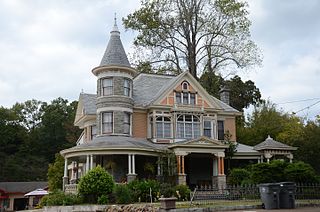
The Short-Dodson House is a historic house at 755 Park Avenue in Hot Springs, Arkansas. It is a 2-1/2 story masonry structure, its exterior finished in a combination of stone, brick, and wood. It has asymmetrical massing with projecting gables of varying sizes and shapes, and a round corner turret, with an undulating single-story porch wrapping around its south side. It was designed by Joseph G. Horn, and built c. 1902 for Dr. Omar Short, one of many doctors whose homes lined Park Avenue.






















